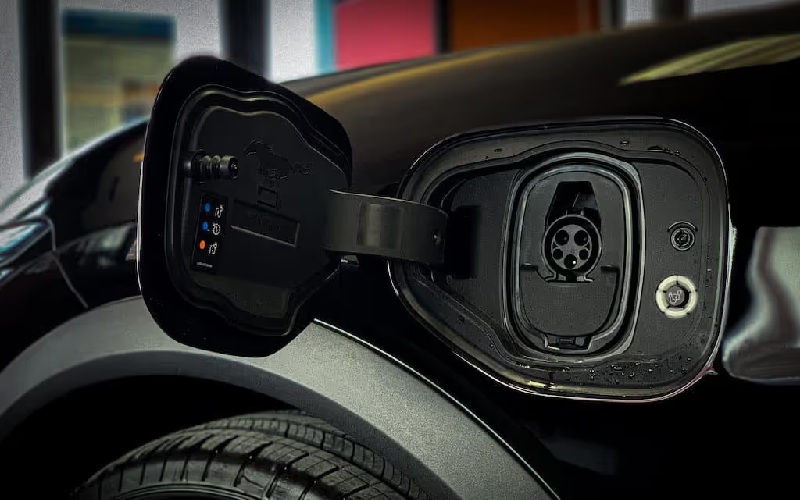2025 Ford EcoSport: Engine, Maintenance, and Power Systems
The Ford EcoSport continues to offer a compelling package in the subcompact SUV segment, combining efficiency, practicality, and modern technology. Central to its appeal is the powertrain, which has been refined for the latest model year to deliver enhanced performance and reliability. Engine Options and Performance The Ford EcoSport engine lineup offers two distinct powertrain […]
The Ford EcoSport continues to offer a compelling package in the subcompact SUV segment, combining efficiency, practicality, and modern technology. Central to its appeal is the powertrain, which has been refined for the latest model year to deliver enhanced performance and reliability.

Engine Options and Performance
The Ford EcoSport engine lineup offers two distinct powertrain options, catering to different driver preferences and requirements.
1.0-Litre EcoBoost Engine
The standard powerplant across most trim levels is an efficient 1.0-litre three-cylinder EcoBoost engine. This turbocharged unit delivers:
- Approximately 125 horsepower
- Roughly 170 Nm of torque
- Direct fuel injection technology
- Integrated exhaust manifold
- Auto start-stop functionality
This compact yet capable engine provides the EcoSport with adequate power for urban environments while maintaining excellent fuel efficiency. The engine size may seem modest, but its turbocharged design ensures responsive acceleration when needed.
2.0-Litre Ti-VCT Engine
Available exclusively on models equipped with Intelligent 4WD, the naturally aspirated 2.0-litre four-cylinder Ti-VCT (Twin independent Variable Camshaft Timing) engine offers:
- Approximately 166 horsepower
- Roughly 202 Nm of torque
- Enhanced towing capability
- More robust performance for challenging driving conditions
- Marginally increased fuel consumption compared to the 1.0-litre option
This larger engine option provides a noticeable boost in performance, particularly when carrying passengers or cargo, or when traversing challenging terrain with the Ford EcoSport 4WD system engaged.
Transmission Systems
Both engine options pair with an 8-speed automatic transmission, which represents an upgrade over previous models. This transmission delivers:
- Smoother shifts compared to earlier 6-speed units
- Enhanced fuel efficiency through optimized gear ratios
- Sport mode for more responsive acceleration
- Manual shift capability via paddle shifters (on select trims)
The Ford EcoSport transmission has been calibrated to optimize the performance characteristics of each engine option while enhancing overall efficiency.
Fuel Efficiency
The Ford EcoSport delivers competitive fuel economy figures that help minimize operating costs:
1.0-Litre EcoBoost (FWD)
- Approximately 8.5 L/100km in urban driving
- Approximately 7.0 L/100km on highways
- Approximately 7.8 L/100km combined
2.0-Litre Ti-VCT (4WD)
- Approximately 10.2 L/100km in urban driving
- Approximately 8.0 L/100km on highways
- Approximately 9.2 L/100km combined
These Ford EcoSport fuel economy l/100km figures demonstrate the vehicle’s efficiency within its segment, particularly with the 1.0-litre EcoBoost engine option.
Battery System and Electrical Components
The Ford EcoSport features an enhanced electrical system designed to support its array of modern features and technologies.
Battery Specifications
The standard Ford EcoSport battery is a 12-volt maintenance-free unit with the following characteristics:
- BXT-96R-59 group size for most models
- Cold Cranking Amps (CCA): 590-690 (depending on engine option)
- Reserve Capacity: Approximately 100 minutes
- Enhanced durability for reliable starting in extreme temperatures
The battery management system monitors charging status and alerts drivers when maintenance might be required, helping to prevent unexpected failures.
Battery Maintenance
For optimal performance and longevity, the Ford EcoSport battery requires minimal but important maintenance:
- Regular inspection of terminal connections for corrosion
- Ensuring proper charging through sufficient driving time
- Avoiding extended periods of inactivity
- Periodic voltage testing, particularly before winter months
Battery Replacement
When Ford EcoSport battery replacement becomes necessary, owners should:
- Select a battery that matches or exceeds the original specifications
- Ensure proper installation to prevent electrical system issues
- Consider having the charging system checked simultaneously
- Reset any electrical systems that may require recalibration after battery disconnection
Maintenance Requirements
The Ford EcoSport has been designed with serviceability in mind, allowing for straightforward maintenance procedures that help keep ownership costs reasonable.
Regular Service Intervals
The recommended maintenance schedule includes:
- Oil and filter changes: Every 8,000 km or 6 months (whichever comes first)
- Tire rotation: Every 8,000 km
- Cabin air filter replacement: Every 24,000 km
- Engine air filter inspection: Every 24,000 km
- Brake fluid service: Every 3 years, regardless of mileage
- Coolant replacement: Initial change at 192,000 km, then every 96,000 km
Following this maintenance schedule is crucial for ensuring reliability and maintaining performance over the vehicle’s lifespan.
Fluid Specifications
The EcoSport requires specific fluids to maintain optimal performance:
- Engine oil: 5W-20 synthetic blend for the 1.0L EcoBoost; 5W-30 for the 2.0L Ti-VCT
- Transmission fluid: MERCON® ULV automatic transmission fluid
- Brake fluid: DOT 4 Low Viscosity (LV)
- Coolant: Orange-colored Motorcraft® Antifreeze/Coolant
- Power steering fluid: MERCON® LV (for models with hydraulic power steering)
Using the correct fluids is essential for the longevity of the mechanical components.
Common Maintenance Procedures
Several maintenance procedures are significant for the EcoSport reliability:
Oil Change Process
Regular oil changes are vital for the EcoSport turbocharged engines:
- The oil fill cap is on top of the engine
- The oil filter is accessible from beneath the vehicle
- Oil capacity is approximately 4.3 litres for the 1.0L and 4.6 litres for the 2.0L
- Using the manufacturer-recommended oil grade is essential for turbocharger longevity
Air Filter Maintenance
The engine air filter is a critical component that requires regular inspection:
- Located in a housing on the driver’s side of the engine bay
- Should be inspected every 24,000 km, but may require more frequent replacement in dusty conditions
- A clean air filter contributes significantly to fuel efficiency and engine performance
Cabin Air Filter Replacement
The Ford EcoSport cabin air filter improves interior air quality:
- Located behind the glove compartment
- Recommended replacement every 24,000 km
- May require more frequent replacement in areas with high pollution or pollen
Brake Maintenance
Regular brake system maintenance ensures safety and performance:
- Brake pad inspection recommended every 16,000 km
- Brake fluid replacement every 3 years to prevent moisture contamination
- Brake rotor inspection for wear and warping during tire rotations
Performance Enhancements for 2025
The latest model year brings several performance enhancements that improve the overall driving experience:
Enhanced Cooling System
The cooling system has been upgraded to maintain optimal operating temperatures even during demanding driving conditions. This is particularly beneficial for the turbocharged 1.0-litre EcoBoost engine, which generates more heat relative to its size.
Refined Suspension
The suspension system has been fine-tuned to provide a better balance between comfort and handling:
- Front: Independent MacPherson strut with stabilizer bar
- Rear: Torsion beam with stabilizer bar
- Enhanced shock absorber tuning for improved ride quality
- Revised spring rates for better body control
Braking System Improvements
The EcoSport features an enhanced braking system:
- Front ventilated disc brakes
- Rear drum brakes (SE) or disc brakes (Titanium and SES)
- Updated brake booster for improved pedal feel
- Enhanced brake pad material for better stopping power and reduced noise
Reliability Considerations
While the Ford EcoSport reliability has been a mixed bag in previous generations, the latest model incorporates several improvements aimed at enhancing long-term dependability:
- Strengthened transmission components to address previous Ford EcoSport transmission problems
- Enhanced electrical system connections to reduce intermittent issues
- Improved water drainage in the body structure to prevent corrosion
- Updated seals and gaskets for better protection against the elements
Performance in Various Conditions
The EcoSport performs capably in various driving conditions:
All-Weather Performance
The EcoSport offers features that enhance all-weather capability:
- AdvanceTrac® with Roll Stability Control™
- Intelligent 4WD system (with the 2.0L engine) that continuously monitors traction
- Selectable drive modes including Normal, Eco, Sport, and Slippery (4WD models)
- Heated exterior mirrors for improved visibility in cold weather
Off-Road Capability
While not designed as a dedicated off-road vehicle, the EcoSport offers reasonable capability:
- Ford EcoSport ground clearance of 200 mm
- Approach angle: approximately 21 degrees
- Departure angle: approximately 27 degrees
- Hill start assist and hill descent control (on 4WD models)
These features make the EcoSport capable of handling light off-road duties, particularly when equipped with the 4WD system.
Towing Capability
The Ford EcoSport offers modest towing capabilities:
- Models with the 1.0L EcoBoost engine: up to 680 kg when properly equipped
- Models with the 2.0L Ti-VCT engine: up to 907 kg when properly equipped
The towing capacity makes it suitable for pulling small trailers, lightweight boats, or recreational equipment.
2025 Ford EcoSport: An Engine For Every Lifestyle
The Ford EcoSport offers a range of engine options and features that provide a balance of efficiency, practicality, and capability. With its turbocharged 1.0-litre EcoBoost engine option and available 2.0-litre naturally aspirated alternative, it caters to different driving needs and preferences. Through attentive maintenance and proper care, this engine can provide reliable transportation for years to come, addressing many of the concerns that affected previous generations.
The powertrain refinements, enhanced electrical system, and improved maintenance accessibility all contribute to a more satisfying ownership experience. Whether navigating urban environments or venturing off the beaten path, the EcoSport powertrain and systems deliver consistent performance across various conditions.
Frequently Asked Questions
What type of engine oil should I use in my Ford EcoSport?
- For the 1.0-litre EcoBoost engine, you should use 5W-20 synthetic blend oil. For the 2.0-litre Ti-VCT engine, use 5W-30. Using the correct viscosity is important for proper engine protection, especially for the turbocharged 1.0-litre engine.
How often should I change the oil in my Ford EcoSport?
- You should change the oil and filter every 8,000 kilometers or 6 months, whichever comes first. However, if you frequently drive in severe conditions (extreme temperatures, dusty environments, or short trips), you may need to change the oil more frequently.
Does the Ford EcoSport have a timing belt or chain?
- The 1.0-litre EcoBoost engine uses a timing belt that should be replaced every 160,000 kilometers or 10 years. The 2.0-litre Ti-VCT engine uses a timing chain designed to last the lifetime of the engine under normal operating conditions and doesn’t require scheduled replacement.
How long should the battery last in a Ford EcoSport?
- Under normal conditions, the battery should last approximately 3-5 years. However, extreme temperatures, short driving trips, and the use of electrical accessories can reduce battery life. Regular testing, especially before winter, can help prevent unexpected failures.
Is the EcoSport available with four-wheel drive?
- Yes, it is available with an Intelligent 4WD system, but only when equipped with the 2.0-litre Ti-VCT engine. The system continuously monitors traction conditions and automatically transfers power between the front and rear wheels as needed for optimal traction.



